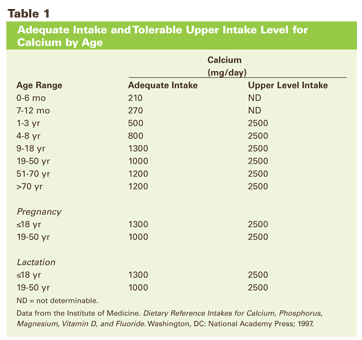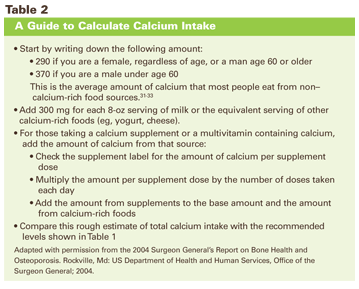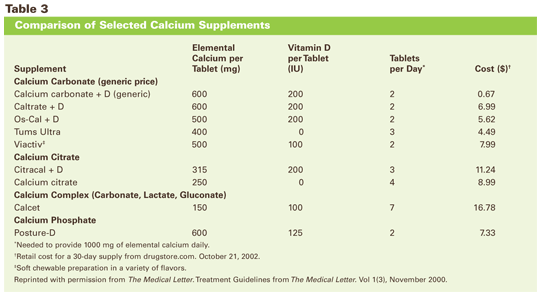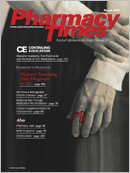Publication
Article
Pharmacy Times
Calcium Supplementation for Osteoporosis
Author(s):
Calcium is a fundamental part of any treatment program to reduce osteoporosis-associated fracture risk. The majority of patients treated for osteoporosis are postmenopausal women,1 who often lack sufficient dietary calcium to meet daily requirements.2
Compounding this problem is a lack of awareness and management of osteoporosis risk. A recent health plan survey found that only 63% of postmenopausal women discuss osteoporosis with their health care providers, and only 57% discuss specifically the importance of calcium in reducing fracture risk.3
Reports from several retrospective chart reviews highlight the problem. In these studies, only 4% to 27% of patients who sustained an osteoporotic fracture were advised to take supplemental calcium.4-6
Maintenance of optimal bone health is important, because osteoporosis typically is asymptomatic until complicated by fracture.7 Moreover, once a patient sustains an osteoporotic fracture, he or she is at even greater risk for additional fractures.8,9
According to the National Osteoporosis Foundation (NOF), ~30 million women are at risk for developing osteoporosis, and this number is expected to increase to >40 million by the year 2020.1 Despite a growing awareness of the problem in the pharmacy community and increased efforts aimed at reducing fracture risk, osteoporosis still remains responsible for >1.5 million fractures each year in the United States.1
According to a recent survey conducted by Information Resources Inc,10 nearly 75% of women who fill a prescription for a bisphosphonate purchase the equivalent of less than 1 calcium tablet per day.10 Pharmacists have the opportunity to be proactive in helping patients identify their supplemental calcium needs and reinforcing the importance of proper dosing and adherence to prescribed medications.
Calcium Intake
Adequate intake levels for calcium have been defined based on age. Current recommendations are 1000 mg/day if the patient is 19 to 50 years of age and 1200 mg/day if the patient is =51 years of age (Table 1).11 The NOF recommends an intake of 1200 mg/day from dietary and supplemental sources for women >50 years.7 Unfortunately, the calcium intake of most Americans falls considerably short of current recommendations (Figure).12-14 In postmenopausal women, the median daily intake is ~700 mg.14


Helping to Identify Patients at Risk
Pharmacists can help identify those at risk for osteoporosis by paying attention to a patient's age, menopausal status, and medication-use patterns. If a patient is at risk, the pharmacist can suggest bone mineral density assessment. There are a number of medications associated with bone loss and osteoporosis that should trigger an intervention13,15:
- Systemic corticosteroids
- Phenytoin
- Barbiturates
- Heparin
- Levothyroxine
Optimizing the Efficacy of Osteoporosis Therapy
The primary goal in treating osteoporosis is to reduce the risk of fracture. Both calcium and pharmacotherapy play important roles in meeting this goal. The wealth of evidence supports a benefit from calcium supplementation on bone health and fracture risk, particularly when patients are adherent to their regimen.16-24
For women undergoing osteoporosis therapy, the greatest clinical benefit can be expected from a combination of antiresorptive therapy and calcium.21 Indeed, most major clinical trials for osteoporosis have included calcium supplementation as an integral part of the treatment regimen. Compared with calcium supplementation alone, the combination of calcium plus prescription medication has resulted in a substantial reduction of fracture risk in several trials.25-28
Unfortunately, many women receiving osteoporosis therapy do not take proper amounts of calcium supplements or do not take supplements correctly. Nearly three quarters of women filling bisphosphonate prescriptions purchase insufficient calcium supplements (less than the equivalent of 1 calcium tablet per day), and nearly one quarter take their calcium supplements too soon after taking their bisphosphonate.10 Pharmacists are in a unique position to reinforce the importance of calcium supplementation to both medical colleagues and patients who are prescribed pharmacologic agents for the prevention or treatment of osteoporosis.
Patient Counseling
All patients who are candidates for pharmacotherapy should be counseled on the importance of adequate intake of calcium and vitamin D.7 Serum calcium levels are not useful for determining adequate calcium intake. Therefore, in order to ensure that patients receive adequate amounts of calcium daily (ie, at least 1200 mg/day), pharmacists should be familiar with the calcium content of foods and the various dosage levels of calcium in available supplements. Foods rich in calcium include dairy products, green vegetables, beans, fish, and fortified juices.29 Patient education materials on dietary calcium sources are available from the National Institutes of Health at http://dietary-supplements.info.nih.gov/factsheets/calcium.asp and the Centers for Disease Control and Prevention at http://www.cdc.gov/powerfulbones/parents/toolbox/calculator.html.
The US Department of Health and Human Services provides a simple method for estimating daily dietary calcium intake (Table 2).30-33 For patients whose daily dietary intake falls short of the targeted amounts, pharmacists are encouraged to recommend an increase in dietary calcium and a calcium supplement in order to consistently meet daily requirements.7 The calcium content of several popular supplements is shown in Table 3.34


Specific recommendations regarding calcium supplements include the following23:
?Calcium tablets should be taken with meals and are best absorbed by the body when taken in doses of 500 mg or less. Supplement doses above this level should be divided so that they are not consumed in a single setting.30
?Calcium absorption is similar among the different formulations when taken with food35
?Pharmacists can reassure postmenopausal patients that calcium supplements manufactured according to US Pharmacopeia requirements have a standardized dose and are without significant impurities36
?Calcium interferes with the absorption of bisphosphonates such as alendronate (Fosamax), risedronate (Actonel), and once-monthly ibandronate (Boniva). Therefore, patients taking one of these agents should be told to wait at least 30 minutes before taking calcium supplements (60 minutes with ibandronate).37-39 Patients also should receive counseling on proper bisphosphonate administration technique in order to minimize the risk of gastrointestinal adverse events.
?Patients should be advised to comply with all recommended dosing guidelines
Conclusion
Calcium supplementation is a key component in the management of osteoporosis. Many postmenopausal women have dietary calcium intakes below recommended guidelines. Pharmacists are in a unique position to counsel postmenopausal patients about the importance of supplemental calcium to be incorporated in their osteoporosis treatment program.
Acknowledgments
The author would like to thank John Zoidis, MD, and Rick Davis, MS, RPh, who provided editorial assistance in the preparation of this manuscript.
Dr. Lloyd is director of the Auburn University Pharmaceutical Care Center and associate professor of pharmacy practice at Harrison School of Pharmacy, Auburn University, Ala.
References
1. National Osteoporosis Foundation. America's Bone Health: The State of Osteoporosis and Low Bone Mass in Our Nation. Washington, DC: National Osteoporosis Foundation; 2002.
2. Feskanich D, Willett WC, Colditz GA. Calcium, vitamin D, milk consumption, and hip fractures: a prospective study among postmenopausal women. Am J Clin Nutr. 2003;77(2):504-511.
3. Gallagher TC, Geling O, Comite F. Missed opportunities for prevention of osteoporotic fracture. Arch Intern Med. 2002;162(4):450-456.
4. Kiebzak GM, Beinart GA, Perser K, Ambrose CG, Siff SJ, Heggeness MH. Undertreatment of osteoporosis in men with hip fracture. Arch Intern Med. 2002;162(19):2217-2222.
5. Follin SL, Black JN, McDermott MT. Lack of diagnosis and treatment of osteoporosis in men and women after hip fracture. Pharmacotherapy. 2003;23(2):190-198.
6. Harrington JT, Broy SB, Derosa AM, Licata AA, Shewmon DA. Hip fracture patients are not treated for osteoporosis: a call to action. Arthritis Rheum. 2002;47(6):651-654.
7. National Osteoporosis Foundation. Physician's Guide to Prevention and Treatment of Osteoporosis. Washington, DC: National Osteoporosis Foundation; 2003.
8. Taylor BC, Schreiner PJ, Stone KL, et al. Long-term prediction of incident hip fracture risk in elderly white women: study of osteoporotic fractures. J Am Geriatr Soc. 2004;52(9):1479-1486.
9. Klotzbuecher CM, Ross PD, Landsman PB, Abbott TA 3rd, Berger M. Patients with prior fractures have an increased risk of future fractures: a summary of the literature and statistical synthesis. J Bone Miner Res. 2000;15(4):721-739.
10. P&G Pharmaceuticals. Inside the calcium conundrum: women may not take the proper amount of calcium or they may take it incorrectly. Available at: www.pgpharma.com/news_20050613.shtml. Accessed January 16, 2007.
11. Institute of Medicine. Dietary Reference Intakes for Calcium, Phosphorus, Magnesium, Vitamin D, and Fluoride. Washington, DC: National Academy Press; 1997.
12. Ervin RB, Wang CY, Wright JD, Kennedy-Stephenson J. Dietary intake of selected minerals for the United States population: 1999-2000. Adv Data. 2004;341:1-5.
13. NIH Consensus Development Panel on Osteoporosis Prevention, Diagnosis, and Therapy. Osteoporosis prevention, diagnosis, and therapy. JAMA. 2001;285(6):785-795.
14. Looker AC. Interaction of science, consumer practices and policy: calcium and bone health as a case study. J Nutr. 2003;133(6):1987S-1991S.
15. Zagaria MAE. Senior care: osteoporosis and the prediction of fracture risk. US Pharmacist. 2001;26(9):1-8.
16. Chapuy MC, Arlot ME, Duboeuf F, et al. Vitamin D3 and calcium to prevent hip fractures in elderly women. N Engl J Med. 1992;327(23):1637-1642.
17. Chapuy MC, Arlot ME, Delmas PD, Meunier PJ. Effect of calcium and cholecalciferol treatment for three years on hip fractures in elderly women. BMJ. 1994;308(6936):1081-1082.
18. Dawson-Hughes B, Harris SS, Krall EA, Dallal GE. Effect of calcium and vitamin D supplementation on bone density in men and women 65 years of age or older. N Engl J Med. 1997;10:670-676.
19. Ensrud KE, Duong T, Cauley JA, et al. Low fractional calcium absorption increases the risk for hip fracture in women with low calcium intake. Study of Osteoporotic Fractures Research Group. Ann Intern Med. 2000;132(5):345-353.
20. Shea B, Wells G, Cranney A, et al. Calcium supplementation on bone loss in postmenopausal women. Cochrane Database Syst Rev. 2004(1):CD004526.
21. Boonen S, Rizzoli R, Meunier PJ, et al. The need for clinical guidance in the use of calcium and vitamin D in the management of osteoporosis: a consensus report. Osteoporos Int. 2004;15(7):511-519.
22. Prince RL, Devine A, Dhaliwal SS. Results of a 5-year, double-blind, placebo-controlled trial of calcium supplementation (CAIFOS): clinical fracture outcomes. Presented at: American Society for Bone and Mineral Research 26th Annual Meeting, 2004; Seattle, WA.
23. Porthouse J, Cockayne S, King C, et al. Randomised controlled trial of calcium and supplementation with cholecalciferol (vitamin D3) for prevention of fractures in primary care. BMJ. 2005;330(7498):1003.
24. RECORD Trial Group. Oral vitamin D3 and calcium for secondary prevention of low-trauma fractures in elderly people (Randomised Evaluation of Calcium Or vitamin D, RECORD): a randomised placebo-controlled trial. Lancet. 365:1621-1628.
25. Harris ST, Watts NB, Genant HK, et al. Effects of risedronate treatment on vertebral and nonvertebral fractures in women with postmenopausal osteoporosis: a randomized controlled trial. Vertebral Efficacy with Risedronate Therapy (VERT) Study Group. JAMA. 1999;282(14):1344-1352.
26. Neer RM, Arnaud CD, Zanchetta JR, et al. Effect of parathyroid hormone (1-34) on fractures and bone mineral density in postmenopausal women with osteoporosis. N Engl J Med. 2001;344(19):1434-1441.
27. Reginster J, Minne HW, Sorensen OH, et al. Randomized trial of the effects of risedronate on vertebral fractures in women with established postmenopausal osteoporosis. Vertebral Efficacy with Risedronate Therapy (VERT) Study Group. Osteoporos Int. 2000;11(1):83-91.
28. Cummings SR, Black DM, Thompson DE, et al. Effect of alendronate on risk of fracture in women with low bone density but without vertebral fractures: results from the Fracture Intervention Trial. JAMA. 1998;280(24):2077-2082.
29. US Department of Agriculture, Agricultural Research Service. 2005. USDA National Nutrient Database for Standard Reference, Release 18. Nutrient Data Laboratory Home Page. Available at: www.ars.usda.gov/ba/bhnrc/ndl. Accessed January 16, 2007.
30. US Department of Health and Human Services. Bone health and osteoporosis: a report of the Surgeon General. Rockville, MD; 2004.
31. Cook AJ, Friday JE. Food mixture or ingredient sources for dietary calcium: shifts in food group contributions using four grouping protocols. J Am Diet Assoc. 2003;103(11):1513-1519.
32. Weinberg LG, Berner LA, Groves JE. Nutrient contributions of dairy foods in the United States. Continuing Survey of Food Intakes by Individuals, 1994-1996, 1998. J Am Diet Assoc. 2004;104(6):895-902.
33. Wright JD, Wang CY, Kennedy-Stephenson J, Ervin RB. Dietary intake of ten key nutrients for public health, United States: 1999-2000. Adv Data. 2003(334):1-4.
34. Medical Letter Consultants. Calcium supplements. Med Lett Drugs Ther. 2000;42(1075):29-31.
35. Heaney RP, Dowell MS, Barger-Lux MJ. Absorption of calcium as the carbonate and citrate salts, with some observations on method. Osteoporos Int. 1999;9(1):19-23.
36. National Safety Council. Q&A Regarding Lead in Dietary Calcium Supplements. Available at: www.nsc.org/issues/lead/calciumlead.htm. Accessed January 16, 2007.
37. Borah B, Dufresne TE, Chmielewski PA, Johnson TD, Chnies A, Manhart MD. Risedronate preserves bone architecture in postmenopausal women with osteoporosis as measured by three-dimensional microcomputed tomography. Bone. 2004;34(4):736-746.
38. Fosamax (alendronate sodium). Full prescribing information. Whitehouse Station, NJ: Merck & Co Inc; 2004.
39. Schimmer RC, Bauss F. Effect of daily and intermittent use of ibandronate on bone mass and bone turnover in postmenopausal osteoporosis: a review of three phase II studies. Clin Ther. 2003;25(1):19-34.







